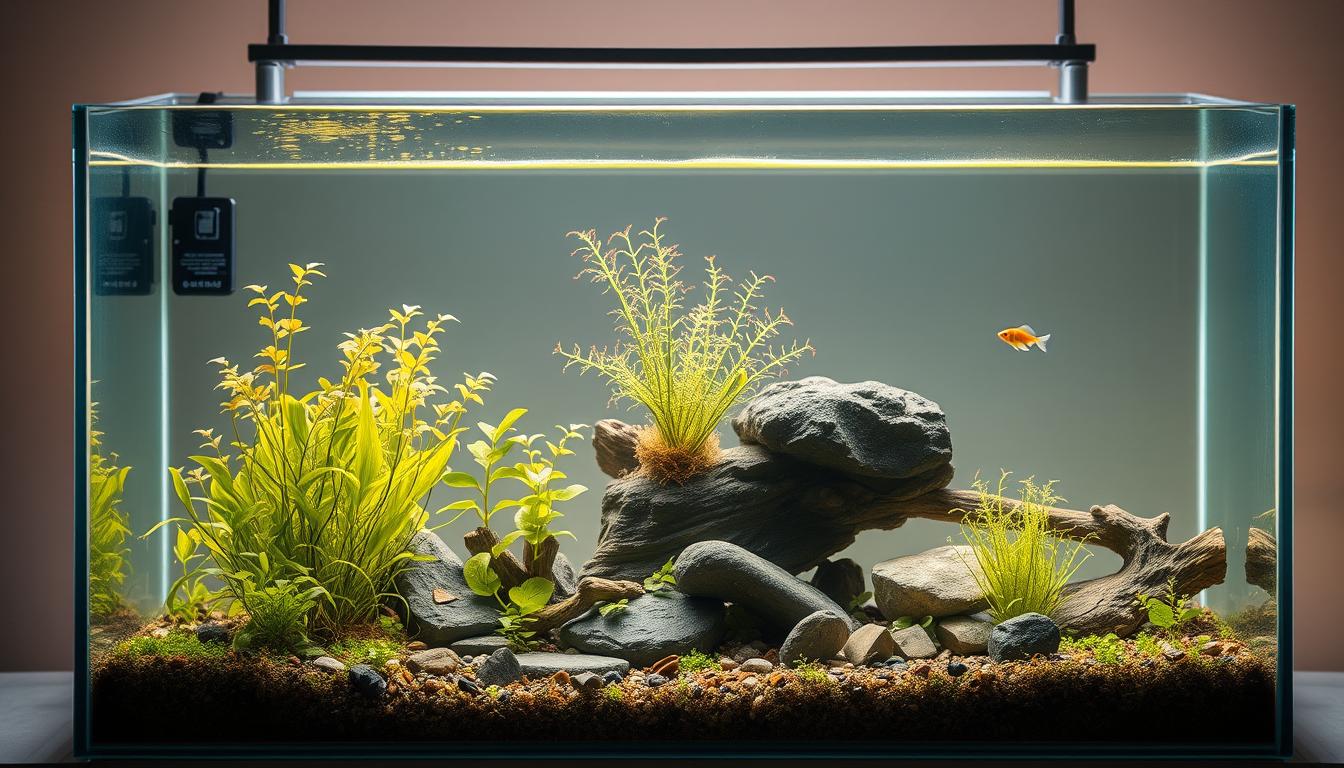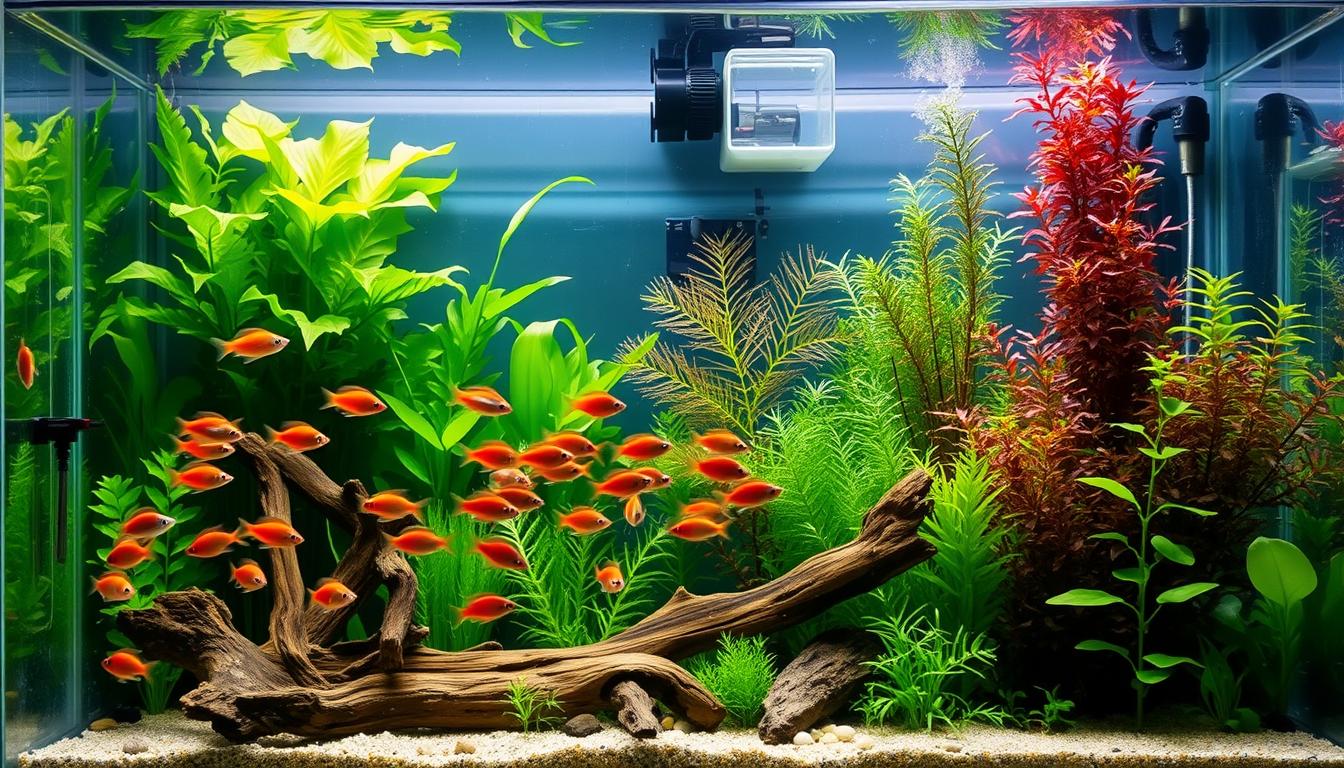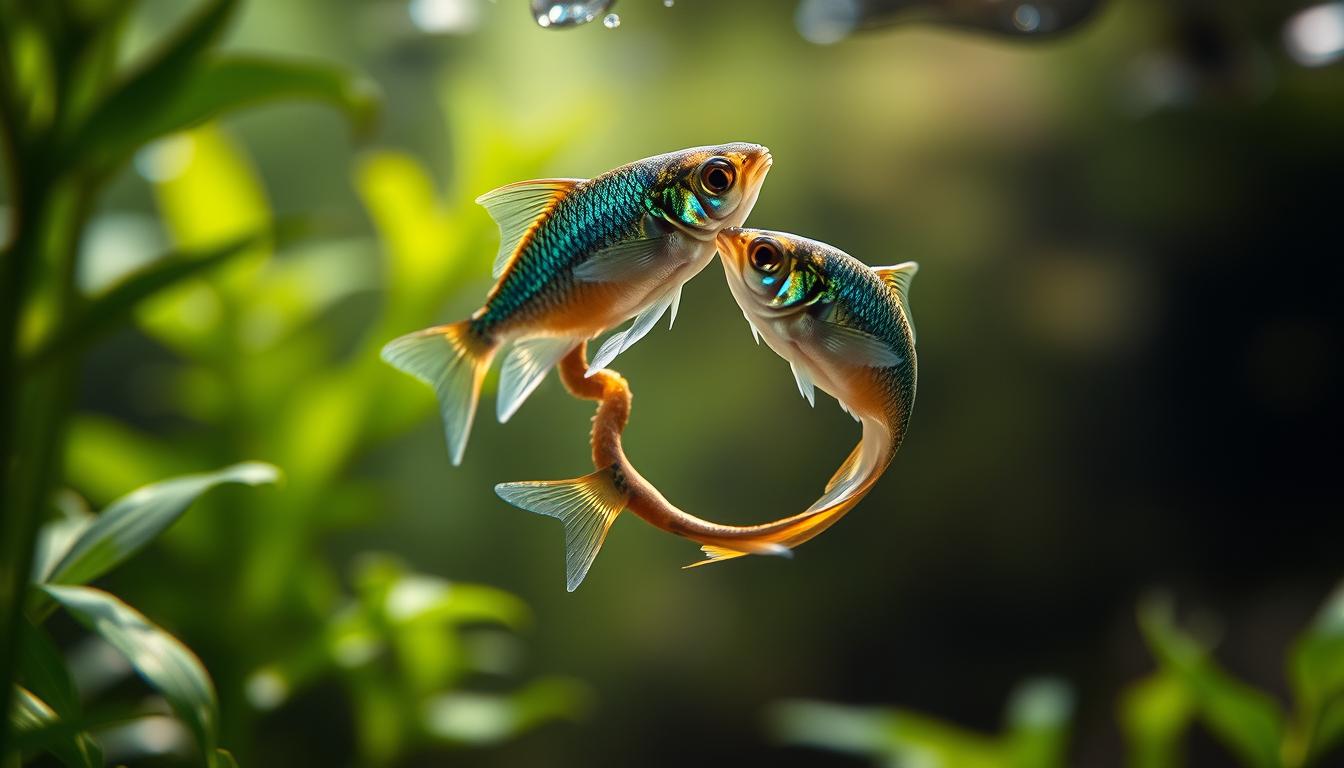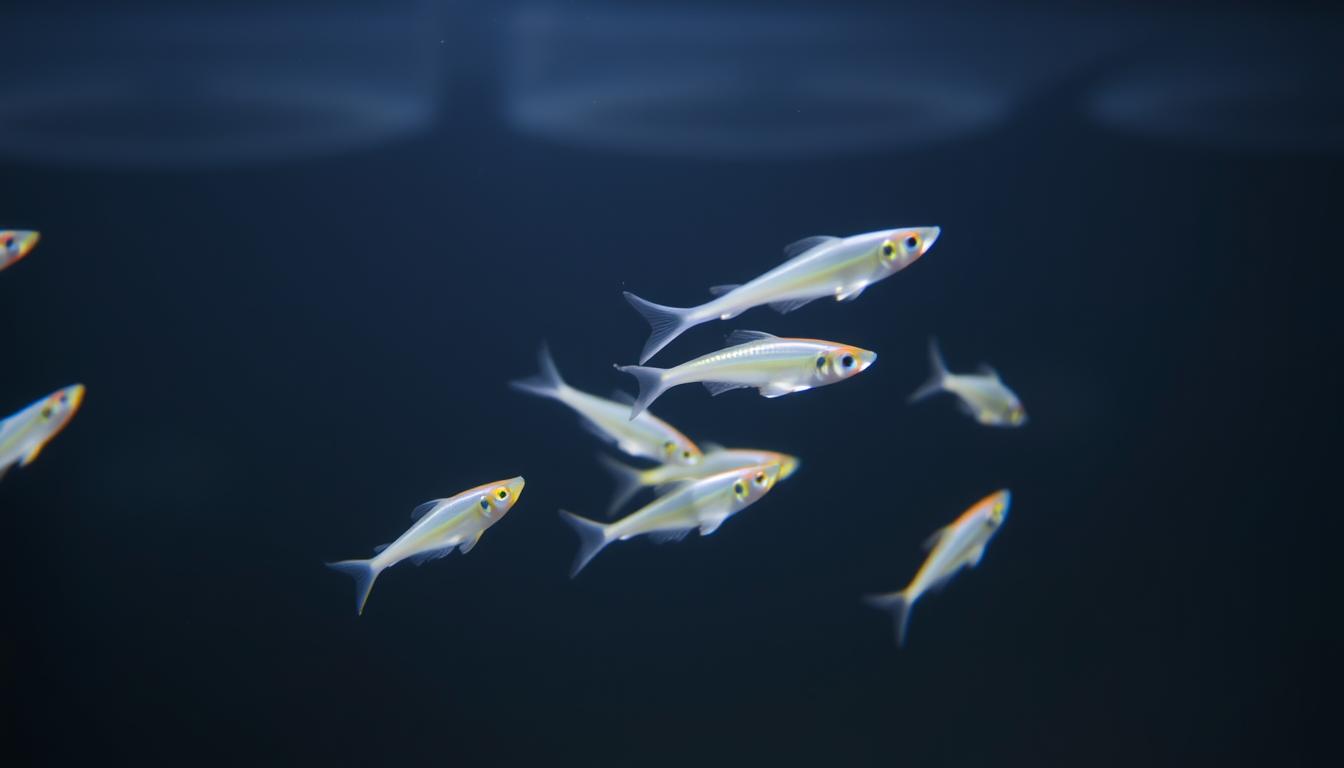How Do Tetra Fish Reproduce and Can I Breed Them at Home?
This post may contain affiliate links.
Are you fascinated by the vibrant colors and peaceful nature of tetra fish, and wondering if you can breed them in your home aquarium?
Tetra fish are a popular choice among aquarists, and their reproduction is a complex process that involves specific water conditions and careful breeding techniques.
Breeding tetras at home can be a rewarding experience, allowing you to witness the complete life cycle of these fascinating fish. With the right guidance, you can successfully breed tetras in your tank, typically ranging from 10 to 20 inches in length.
Key Takeaways
- Understand the basics of tetra fish reproduction
- Learn how to create a suitable environment for breeding tetras
- Discover the steps involved in conditioning pairs and raising fry
- Find out how to overcome common challenges in tetra breeding
- Gain insights into the different tetra species that can be bred at home
Understanding Tetra Fish Biology
To breed tetra fish successfully, it’s essential to understand their biology, including their physical characteristics and natural behavior.
Physical Characteristics of Tetras
Tetra fish are known for their compressed bodies and vibrant coloration patterns. They typically range from 1-2 inches in length and have a lifespan of 2-5 years in captivity. Males are usually smaller and more colorful than females, with more pointed fins.
| Characteristic | Description |
|---|---|
| Body Shape | Compressed |
| Size | 1-2 inches |
| Lifespan | 2-5 years |
| Sexual Dimorphism | Males are smaller and more colorful |
Natural Habitat and Behavior
Tetra fish are native to South American and African freshwater environments. They are schooling fish that prefer to swim in groups of at least 5-6 individuals. In the aquarium, they should be kept in schools of odd numbers to prevent pairing and aggression. Tetras are omnivorous, requiring a diet that includes both meat and plant-based foods.
The Natural Reproduction Process of Tetra Fish
In their natural habitats, tetra fish exhibit unique reproductive strategies that are crucial for their survival and proliferation. Tetra fish are found in various freshwater environments, and their reproduction is often triggered by changes in water conditions, such as those that occur during the rainy season.
Spawning Behaviors in the Wild
Tetra fish display fascinating spawning behaviors. In the wild, they often gather in large groups, and males exhibit courtship behaviors to attract females. The spawning process is typically triggered by changes in water temperature, pH, and hardness, signaling the fish that conditions are favorable for reproduction.
Egg Scattering vs. Egg Depositing Species
Tetras can be categorized into egg-scattering and egg-depositing species. Neon tetras, for example, are egg-scattering tetras that release their eggs among plants, while some species deposit their eggs on specific surfaces. This difference in reproductive strategy is crucial for understanding how to recreate optimal breeding conditions in a home tank.
| Reproductive Strategy | Description | Example Species |
|---|---|---|
| Egg Scattering | Eggs are released among plants or substrate. | Neon Tetras |
| Egg Depositing | Eggs are placed on specific surfaces. | Some Tetra Species |
Understanding these natural reproduction processes is essential for successfully breeding tetra fish at home. By replicating the conditions and strategies used by tetras in the wild, aquarists can increase the chances of successful spawning and fry survival.
Popular Tetra Species for Home Breeding
Home breeding of tetra fish has become increasingly popular, with several species being ideal for this purpose. Many aquarium enthusiasts find breeding tetras rewarding due to their diverse species and relatively manageable breeding requirements.
Neon Tetras and Cardinal Tetras
Neon tetras and cardinal tetras are among the most popular tetra species for home breeding. Both species are known for their vibrant colors and are relatively easy to breed in a well-maintained aquarium. They require specific water conditions, including soft, slightly acidic water, and a separate breeding tank to increase the chances of successful spawning.
Black Skirt and Black Neon Tetras
Black skirt tetras and black neon tetras are other popular choices for home breeders. These species are known for their distinctive appearance and are relatively hardy. They prefer a breeding tank with plenty of hiding places and fine-leaved plants where they can spawn.
Serpae and Ember Tetras
Serpae tetras and ember tetras are also favored among aquarists for their breeding characteristics. Serpae tetras are known for their bright red color, while ember tetras are appreciated for their vibrant orange-red hue. Both species are considered good choices for beginners due to their adaptability and relatively straightforward breeding requirements.
Essential Equipment for Breeding Tetras
The key to successful tetra breeding lies in the proper setup of your breeding tank. To create an ideal environment, you’ll need to select the right equipment.
Breeding Tank Setup
A dedicated breeding tank is essential for successful tetra breeding. Typically, a 5-10 gallon tank is recommended, as it provides a stable environment for the fish. When setting up the tank, consider the adult size of your tetra species and the number of fish you plan to breed. For example, a single adult neon tetra requires at least 10 gallons of tank space, while larger species like the Congo tetra need even more room.
Filtration and Water Movement Requirements
Gentle filtration is crucial in a breeding tank to prevent damage to eggs and fry. Consider using a sponge filter or a gentle hang-on-back filter. Stable water conditions are also vital for the health of your tetras. Regular water changes and monitoring of water parameters will help maintain a healthy environment.

| Equipment | Description | Importance |
|---|---|---|
| Breeding Tank | 5-10 gallon tank for stable environment | High |
| Filtration System | Gentle filtration to prevent egg damage | High |
| Heater and Thermometer | Maintains stable breeding temperatures | High |
| Spawning Mops or Cones | Increases breeding success | Medium |
| Water Testing Equipment | Monitors water parameters | High |
By selecting the right equipment and setting up your breeding tank correctly, you’ll be well on your way to successfully breeding tetras.
Creating the Ideal Water Conditions
To breed tetra fish successfully, it’s crucial to replicate their natural environment, starting with the right water conditions. This involves understanding the specific requirements for temperature, pH, and water hardness that tetras prefer.
Temperature Requirements
Tetras prefer warm water between 72°F and 82°F. To maintain a stable temperature, use an aquatic heater controlled by a thermostat. Daily checks with an aquarium thermometer ensure the temperature remains within the ideal range, fluctuating no more than +/- 2 degrees in 24 hours.
pH and Water Hardness
Different tetra species have specific pH requirements, typically between 6.0 and 7.0. Adjust pH levels safely to avoid stressing the fish. Breeding tetras generally prefer soft water with low General Hardness (GH) and Karbonate Hardness (KH).
Water Quality Maintenance
Regular water testing is crucial during the breeding process. Perform small, frequent water changes to maintain high water quality without disturbing eggs or fry. Use water conditioning products to remove chlorine and chloramine, ensuring a safe environment for your tetras.
Setting Up a Dedicated Breeding Tank
Breeding tetras requires a specific setup that mimics their natural habitat, ensuring the health and success of the breeding process. A dedicated breeding tank is essential for providing the necessary conditions for tetra reproduction.
Tank Size and Configuration
The ideal breeding tank size for tetras typically ranges from 5 to 10 gallons, depending on the species. A smaller tank can be used for smaller tetra species, while larger tanks are more suitable for bigger species or for breeding multiple pairs. The tank should be configured to provide ample hiding places and visual barriers to reduce stress among the breeding pairs.
Substrate and Hiding Places
Tetras thrive in environments with plenty of cover, so incorporating plants, driftwood, and rocks is crucial. Live plants such as Java moss, frogbit, and hornwort are excellent choices as they provide shaded hiding places and help maintain water quality. The substrate should be chosen carefully; options include bare-bottom tanks, marbles, or mesh to protect eggs from being eaten. Additionally, spawning mops and java moss can be used as egg-collection surfaces, mimicking natural environments and protecting the eggs.

Selecting and Conditioning Breeding Pairs
To breed tetra fish successfully, it’s essential to choose healthy, mature breeding pairs. This involves identifying males and females and conditioning them for breeding.
Identifying Males and Females
Identifying the sex of tetras is crucial. Males are typically slimmer and more colorful, while females are rounder, especially when carrying eggs. Observing these differences helps in selecting the right breeding pairs.
Proper Nutrition for Breeding Condition
Tetras need a varied diet to stay healthy. For breeding condition, they require high-protein foods like bloodworms and brine shrimp. Feeding them small amounts one to two times a day stimulates egg production and improves breeding success.
The Tetra Fish Breeding Process
To breed tetra fish, aquarists must first understand the intricacies of their reproductive cycle. This knowledge is crucial for creating an environment that encourages successful spawning.
Introducing Breeding Pairs
Conditioned breeding pairs should be introduced to the breeding tank in the evening. This timing encourages spawning the following morning. It’s essential to ensure the tetras are healthy and well-fed before introduction.
Spawning Triggers and Behaviors
Spawning triggers include changes in water temperature, water changes, and adjustments to the light cycle. Tetras exhibit specific courtship behaviors, such as chasing and color intensification, before spawning.
The Fertilization Process
During spawning, the female tetra fish releases eggs, which are then fertilized by the male. The number of eggs can range from dozens to hundreds, depending on the species and health of the fish.
| Spawning Trigger | Description | Effect on Tetras |
|---|---|---|
| Water Temperature Change | Gradual increase or decrease | Stimulates spawning |
| Water Change | Partial replacement of tank water | Simulates natural environment changes |
| Light Cycle Adjustment | Alteration of lighting duration or intensity | Influences spawning timing |

Egg Care and Development
After successful spawning, the next critical step in tetra fish breeding is ensuring the eggs receive proper care. Many tetra species have a tendency to eat their own eggs, which can significantly reduce the success rate of breeding.
Protecting Eggs from Parents
To prevent this, breeders often remove the parents after spawning or use a protective barrier to safeguard the eggs. This step is crucial for maximizing the survival rate of the eggs.
Incubation Period and Conditions
The incubation period for tetra eggs typically ranges from 24 to 36 hours, depending on the species and water temperature. Maintaining optimal water conditions Beneficial bacteria in the tank also play a significant role in keeping the water quality high.
Caring for Tetra Fry
After hatching, tetra fry need meticulous care to thrive and grow into healthy adult fish. The first few days are crucial for their development.
First Foods for Newborn Fry
Newborn tetra fry require tiny, nutritious foods. Infusoria, liquid fry food, and newly hatched brine shrimp are ideal first foods. Feed them 3-5 times daily in small amounts to promote optimal growth.
Growth Stages and Development
Tetra fry grow rapidly. By 3-4 weeks, they begin to show adult coloration. Monitor water quality closely and maintain a clean tank to prevent health issues.
| Age | Food | Water Change |
|---|---|---|
| 1-3 days | Infusoria | Daily |
| 3-7 days | Liquid fry food | Every other day |
| 1-4 weeks | Brine shrimp | Twice a week |

Common Breeding Challenges
Breeding tetra fish can be a rewarding experience, but it comes with its own set of challenges. Aquarists often encounter issues that can hinder the breeding process, from water quality problems to diseases affecting eggs and fry. Understanding these challenges is crucial for successful tetra breeding.
Egg Fungus and Prevention
Egg fungus is a common issue in tetra breeding, often resulting from poor water quality or inadequate tank maintenance. Preventing egg fungus involves maintaining pristine water conditions and ensuring the breeding tank is clean and well-maintained. Methylene blue baths can be an effective treatment. Regular water changes and monitoring water parameters are key to preventing fungal infections.
Fry Mortality Issues
Fry mortality is another significant challenge, often caused by inadequate nutrition, poor water quality, or disease. Ensuring that fry receive appropriate food and maintaining optimal water conditions can significantly reduce mortality rates. Regular monitoring and quick action against disease outbreaks are crucial for the survival of tetra fry.
Species-Specific Breeding Techniques
Breeding tetra fish requires a deep understanding of the specific needs of different species. Various tetra species have distinct breeding requirements that can significantly impact the success of spawning.
Neon Tetra Breeding Specifics
Neon tetras are known to be challenging to breed due to their requirement for very soft, acidic water. “Successful breeding of neon tetras demands meticulous attention to water quality,” as noted by experienced aquarists. To breed neon tetras, one must replicate their natural habitat closely, maintaining water temperatures between 72-82°F and a pH of around 5.0-6.0.
Rummy Nose and Congo Tetra Variations
Rummy nose tetras and Congo tetras have different breeding requirements. Rummy nose tetras prefer slightly higher temperatures, while Congo tetras are known to be more challenging to breed due to their specific water parameter needs. Congo tetras require a more nuanced approach, with a focus on maintaining optimal water quality and providing ample hiding places for the fish.
By understanding these species-specific breeding techniques, aquarists can increase their chances of successful spawning and raise healthy tetra fry.
Moving Fry to Community Tanks
Successfully introducing tetra juveniles to a community tank involves several key considerations. Tetra fish are active schooling fish that thrive in a peaceful community aquarium. When transitioning them from breeding tanks to community tanks, it’s essential to ensure a smooth integration.
When and How to Introduce Juveniles
Juvenile tetras are ready to be moved to a community tank when they reach 1/2 to 3/4 inch in size. The introduction process should be gradual, starting with acclimation to the community tank’s water parameters. This can be achieved by floating the juveniles in a breeder net or a separate container within the community tank, allowing them to adjust to the water conditions.
Integration with Adult Fish
When integrating young tetras with adult fish, it’s crucial to monitor their behavior and ensure that the adults are not preying on the juveniles. Providing ample hiding places and plants in the community tank can help reduce stress and aggression. Tetras do best in a well-planted aquarium with moderate lighting, and keeping them in schools of six or more of the same species can promote a harmonious environment.
| Key Considerations | Description |
|---|---|
| Size for Transfer | 1/2 to 3/4 inch |
| Acclimation Process | Gradual introduction to community tank water parameters |
| Tank Conditions | Well-planted, moderate lighting |
Maintaining Genetic Diversity
To ensure the health and resilience of tetra fish, maintaining genetic diversity is essential. Genetic diversity helps prevent inbreeding depression, which can lead to reduced fertility and health issues in tetras. By maintaining diverse breeding lines, hobbyists can ensure the long-term viability of their tetra populations.
Preventing Inbreeding
Preventing inbreeding is critical in tetra fish breeding. Inbreeding depression can result in weaker offspring with reduced fertility. To avoid this, breeders should maintain separate breeding lines and select breeding stock from different sources. This practice helps preserve genetic diversity and ensures healthier offspring.
- Maintain separate breeding lines to preserve genetic diversity.
- Select breeding stock from different sources to prevent inbreeding.
- Avoid breeding fish with genetic defects or health issues.
Selecting for Healthy Traits
Selecting for healthy traits is vital in maintaining the overall health of tetra fish populations. Breeders should focus on desirable traits such as vibrant coloration, robust size, and overall health. By prioritizing these traits, breeders can enhance the quality of their tetra fish and contribute to the development of healthy, thriving populations.
- Prioritize breeding fish with vibrant coloration and robust size.
- Focus on overall health when selecting breeding stock.
- Maintain detailed records to track breeding lineages and prevent accidental inbreeding.
Ethical Considerations in Home Breeding
The decision to breed tetra fish at home should be accompanied by a commitment to ethical breeding practices. Breeding tetras requires a thorough understanding of their needs and behaviors. Tetras are schooling fish that thrive in odd-numbered groups of five or more from the same species.
Responsible Breeding Practices
Responsible breeding practices prioritize the health and welfare of the fish. This includes maintaining proper aquarium conditions, avoiding overbreeding, and ensuring that the breeding process does not cause undue stress on the fish. Proper care for the breeding pairs and their offspring is crucial.
Finding Homes for Offspring
Finding suitable homes for the offspring is a critical ethical consideration. Breeders should work with local fish stores, aquarium clubs, and online communities to rehome the fish. It’s also important to educate new owners about proper tetra care to ensure the fish thrive in their new environments.
| Ethical Consideration | Description |
|---|---|
| Responsible Breeding | Prioritizing fish health and welfare |
| Rehoming Offspring | Working with local stores and communities |
| Educating New Owners | Ensuring proper care for tetras |
Conclusion
For those interested in aquarium fish, breeding tetras offers a unique opportunity to witness their life cycle. To achieve success, it’s crucial to understand their biology and habitat needs. Proper tank setup, water conditions, and nutrition are essential. Starting with easier species like black skirt tetras or ember tetras can be beneficial. With patience and attention to detail, hobbyists can enjoy the rewards of breeding tetra fish, including sharing offspring with others. Research and preparation are key to a successful breeding experience in planted tanks.
